Did you know that businesses that optimize their landing pages can see a 223% increase in conversion rates? That’s a great reason to keep refining and getting the most out of your landing pages with the right tools.
Whether you aim to boost signups, enhance usability, accurately track leads, or refine your messaging, the right landing page optimization tools are key to your success.
In this article, we’ll explore our top picks for landing page optimization tools—tested and vetted to help you find the perfect match for your needs. Let’s dive in and discover how these tools can transform your digital marketing efforts.
How to Choose the Right Landing Page Optimization Tool
The key to choosing what works best for you is evaluating main features and then considering potential integrations and usability. Once you draw the line, also consider pricing and value for money. Compare different tools to see which fits your budget and requirements, keeping in mind that personalization can seriously enhance usability.
Key Features of Landing Page Optimization Tools
Let’s dive into the key areas of landing page optimization and the must-have features to look for in each tool.
Remember that those just starting with landing page optimization should choose a tool that covers multiple features from various categories.
Landing Page Builders
Examples: Unbounce, Instapage, Leadpages.
Key features to look for:
- A drag-and-drop interface allowing users to create professional pages without coding.
- Pre-designed templates for various industries and use cases.
- Mobile responsiveness and responsive builder.
- Ideally, a visual or WYSIWYG builder.
- Built-in A/B testing capabilities.
- Native integrations with popular CRMs, email marketing tools, and analytics platforms.
Survey Tools
Examples: SurveyMonkey, Typeform, Qualaroo.
Key features to look for:
- Customizable surveys to collect specific user feedback.
- Targeting options for sending surveys to specific user segments based on behavior or demographics.
- Analytics that provide insights into survey responses.
- Integration with CRMs and email marketing tools to follow up on feedback.
Heatmap Tools
Examples: Mouseflow, Crazy Egg, Hotjar.
Key features to look for:
- Click and tap tracking to see how users are interacting with landing page (LP) elements.
- Scroll tracking to highlight areas of interest or neglect—how far users scroll on the page.
- Mouse movement tracking.
- Segment analysis capabilities to break down behavior by different user segments to identify patterns.
Analytics Tools
Examples: Google Analytics, Kissmetrics, Adobe Analytics, Mouseflow.
Key features to look for:
- Traffic analysis to see how many visitors your page has and where they came from.
- Event tracking to monitor how users interact with the page, including time spent and actions taken.
- Conversion tracking to assess the effectiveness of your landing page in driving conversions.
- Funnel visualization to pinpoint drop-off points in the conversion process.
Speed Optimization Tools
Examples: Pagevitals, GTmetrix, Pingdom.
Key features to look for:
- Page speed insights to check the speed of your landing page and get recommendations for improvement.
- Performance monitoring to be up-to-date with page speed and alerts.
- Image optimization to compress images without losing quality.
- Caching solutions to reduce server load and improve speed.
As you can see, different tools serve different purposes. We’ve organized them to cover a wide range of features and tried to provide diverse options to help you find the best fit.
1. Mouseflow: To Analyze Customer Experience

Mouseflow is a digital experience analytics tool designed to give businesses, big and small, deep insights into user behavior on their landing pages and websites. The platform aims to help businesses understand how visitors interact with their websites, identify blockers or usability issues, and fix them.
What Landing Page Optimization Tools Does Mouseflow Offer?
- The user session replay tool lets you see how visitors interact with your landing pages.
- The website heatmap tool has six types of heatmaps, from the more common click, scroll, and movement to real-time, geographic, and attention heatmaps.
- Conversion funnels to track user journeys and identify drop-off points and areas for improvement.
- Form analytics for in-depth data on form interactions to see where users hesitate or abandon.
- Error tracking helps you identify and analyze user errors to improve site functionality and user experience.
Mouseflow Pros and Cons
Pros:
- Automatic data collection for every page: Mouseflow provides detailed insights into user behavior with heatmaps, session replays, and funnel analysis.
- Easy user feedback collection: Allows direct user feedback collection from users to understand their experience fully.
- Compliance: Mouseflow is fully compliant with all data privacy regulations, including GDPR, CCPA, and others.
- A broad set of integrations: Mouselow integrates with many popular third-party tools.
Cons:
- Overwhelming data: Mouseflow provides extensive data, which can be overwhelming — you need to know where to start and dedicate some time to it.
- No A/B testing tool: A/B testing is essential for landing page optimization, a feature Mouseflow lacks. The good thing is that it integrates well with the most popular A/B testing tools.
- No user journey mapping tool on publicly available plans.
Mouseflow Pricing
- Free plan ✅ Available for small websites with up to 500 monthly recordings.
- Starter plan: $31/month, includes 5,000 monthly sessions and one website.
- Growth plan: $109/month, includes 15,000 monthly sessions and 3 websites.
- Business plan: $219/month, includes 50,000 monthly sessions and 5 websites.
- Pro plan: $399/month, includes 150,000 monthly sessions and 10 websites.
- Enterprise plan: Custom pricing based on specific needs and volume requirements.
Our Verdict on Mouseflow
I, the writer behind this article, am not a part of the Mouseflow team, so I can give my verdict without being too biased. Mouseflow is designed to give businesses an edge in understanding user behavior and optimizing website experiences to match it. With powerful tools like heatmaps, session replays, and form analytics, Mouseflow provides the data needed to refine the user journey and crank up conversion rates with detailed insights.
2. Unbounce: To Build and A/B Test Landing Pages
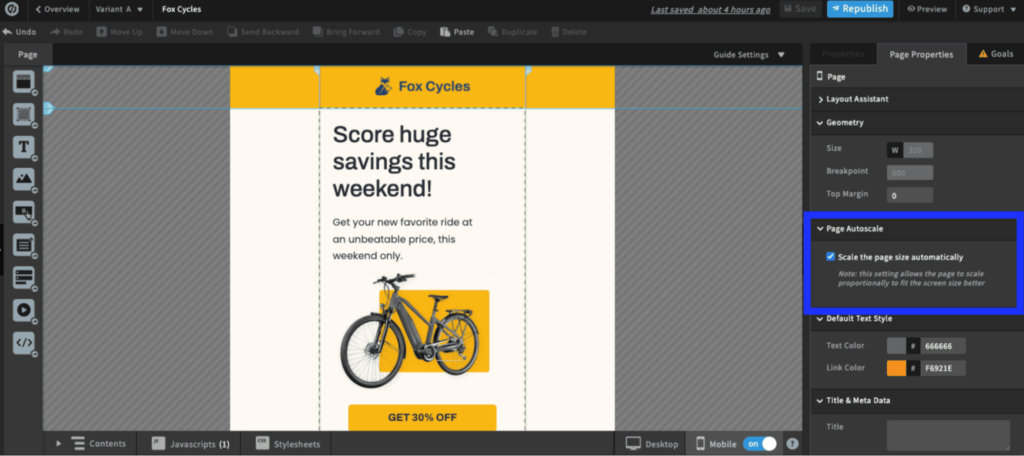
Image source: Unbounce
Unbounce is a household name when it comes to creating and publishing high-converting landing pages without any coding knowledge. It offers a range of tools and integrations that streamline the process of designing, testing, and optimizing landing pages.
What we like most about Unbounce is that it makes it easy to get things done, no matter your professional background. We also enjoy the practicality of their platform and the fact that they regularly publish articles evaluating high-converting landing pages and incorporate the best practices into templates that help you get better results faster.
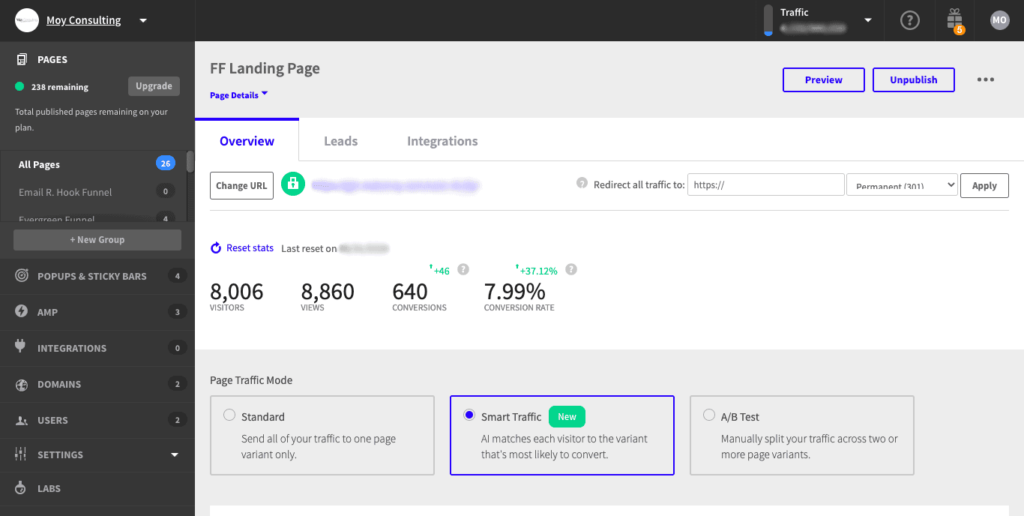
Image source: Unbounce community
What Landing Page Optimization Tools Does Unbounce Offer?
- Landing page builder with smart features and industry-optimized templates to help you get more sales and signups.
- Native A/B testing capabilities allow you to test different versions of landing pages and determine which one performs better.
- Powerful integrations with CRM, email marketing, and analytics tools.
- Pop-ups and sticky bars that engage visitors with targeted messages and offers.
- Mobile responsiveness to ensure landing pages look great on all devices.
- AI optimization features to send visitors to the most suitable landing page automatically.
Unbounce Pros and Cons
Pros
- Intuitive interface: Unbounce has an easy-to-use visual builder with AI suggestions.
- High-converting templates: Includes a wide range of professionally designed templates for every use case.
- AI assistant: Improves personalization and relevance with dynamic text replacement.
Cons
- Expensive: Small businesses or those starting out might find it a bit expensive.
- Difficult to master: While user-friendly, some features may require coding or advanced editing.
- Basic reporting: Has limited built-in analytics since it relies on integrations for more in-depth numbers.
Unbounce Pricing
- Free plan ❌
- Build: $99/month, suitable for small businesses and startups.
- Experiment: $149/month, includes A/B testing and advanced targeting.
- Optimize: $249/month, offers more advanced features and higher traffic limits.
- Concierge: starting at $649/month, designed for large enterprises with high traffic and advanced needs.
Our Verdict on Unbounce
Unbounce’s optimization tools help marketers create and refine high-converting landing pages. Its user-friendly interface and robust features, such as A/B testing and dynamic text replacement, make it an excellent choice for businesses looking for a simple yet flexible landing page builder for their digital marketing team.
3. HubSpot: To Create, Test, and Optimize Landing Pages
HubSpot is a comprehensive inbound marketing, sales, and service platform renowned for its powerful marketing automation capabilities. Among other things, it includes a landing page builder tool for efficiently creating, testing, and optimizing landing pages.
Hubspot’s main power is that its marketing suite, like every other product, is surprisingly easy to use and well-connected with tools for other departments. Their landing page builder and forms work like a charm to help anyone get and close leads. There are no useless or overly complex features.
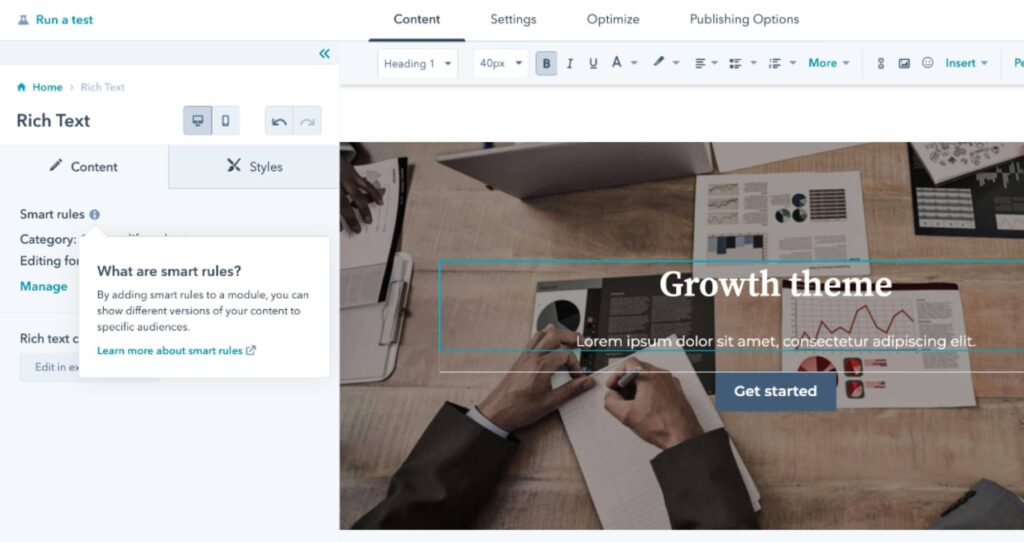
Image source: Hubspot
What Landing Page Optimization Tools Does HubSpot Offer?
HubSpot’s entire product suite offers all the features you could ever need, but for the scope of the article, we will focus on the ones related to landing page optimization:
- A/B testing: Determine the most effective designs and content directly from the Hubspot dashboard.
- Thousands of landing page templates: The HubSpot Marketplace offers over 350 customizable templates tailored to different industries and goals. Most are free.
- Integrated lead capture forms: Since HubSpot also offers a customer relations management tool (CRM), having forms for collecting visitor information makes perfect sense. All the data from the forms immediately ends up in the CRM, which is very convenient
- Built-in SEO tools to optimize landing pages for better search engine visibility.
HubSpot Pros and Cons
Pros:
- Seamless integration: Hubspot’s landing page builder easily connects with its CRM or Sales Hub and other marketing tools for a unified experience.
- Smart content features: Allow users to tailor their experience according to their preference.
- Powerful analytics: Detailed analytics and reporting capabilities offer valuable insights for optimization.
Cons
- Expensive: Hubspot can quickly become expensive, especially for small businesses or startups.
- Complicated product packages: The extensive range of features HubSpot includes in its suites may require more time to understand and utilize fully.
- Limited customization and functionality: Some users find its customization options less flexible compared to standalone landing page builders.
HubSpot Pricing
HubSpot offers different product packages, such as the Marketing Hub, Operations Hub, Content Hub, or software bundles. You’ll want the HubSpot Content Marketing Software if you are only interested in the landing page capabilities.
- Free plan ✅ – Available but extremely limited, even though it offers to connect a custom domain.
- Starter plan: This plan starts at $20/month and includes landing pages and a website builder, as well as the option to remove “built with HubSpot” from your website.
- Professional plan: $500/month, includes personalization tokens, live chat, and email support.
- Enterprise plan: $1,500/month. It offers content remix, brand voice, dynamic personalization, memberships, and gated content.
We strongly recommend buying a bundle or combining the Content Marketing Software package with the Marketing Software package.
Our Verdict on HubSpot
We appreciate the platform’s user-friendly interface and robust features, such as A/B testing, smart content, and detailed analytics.
While the pricing may be steep for smaller businesses, it provides significant value and efficiency for those willing to invest. For businesses seeking a holistic approach to marketing automation and growth, HubSpot is an excellent all-in-one product for building and optimizing landing pages, and more.
4. Five Second Test: To Know What Customer Think
We often get caught up in the most minute details of landing page optimization, forgetting about the bigger picture. The Five-Second Test is an excellent reality check for those who know they are too detail-oriented and want a third-party opinion.
Five Second Test is one of many Lyssna user research products. It helps marketers and designers quickly assess the effectiveness of their landing page designs. It captures users’ first impressions within five seconds, providing valuable insights into what stands out and what users recall.
It is especially useful for understanding how well key messages and design elements are communicated quickly.
What Landing Page Optimization Tools Does Five Second Test Offer?
- Rapid-fire user testing: Captures users’ first impressions within five seconds to understand what elements stand out.
- There are different test formats: First-click testing, card sorting, surveys, prototype testing, research panels, and tree testing.
Five Second Test Pros and Cons
Pros:
- Super easy to get started: The ease of use makes it accessible for users of all skill levels.
- Real user testing: It does just what it says—helps identify which elements catch users’ attention within the first few seconds.
Cons:
- Limited feedback: Focuses mainly on first impressions and may not provide comprehensive details about long-term user behavior.
- Lacks advanced features: No additional functionality like analytics or A/B testing.
- Conflicting feedback: Insights depend on the sample size and demographics, affecting result reliability.
Five Second Test Pricing
The pricing tiers below apply to the platform’s entire product line. The Five Second Test can also be done for free by sharing the link with your peers or for $1 per response using Lyssna’s panel of experts.
- Free plan ✅ – Available if you invite your peers
- Basic Plan: $89/month, includes 3 seats, 5-minute length tests, surveys & more.
- Pro Plan: $199/month, includes unlimited tests, 30 transcript hours per month & more.
- Enterprise Plan: Custom pricing based on specific needs and scale.
Our verdict on Five Second Test
The Five Second Test is great for quickly assessing the effectiveness of landing page designs and identifying key elements that capture users’ attention. However, its limited scope and basic features make it ideal for use together with more comprehensive landing page optimization tools.
5. Wynter: For In-Depth Customer Insights
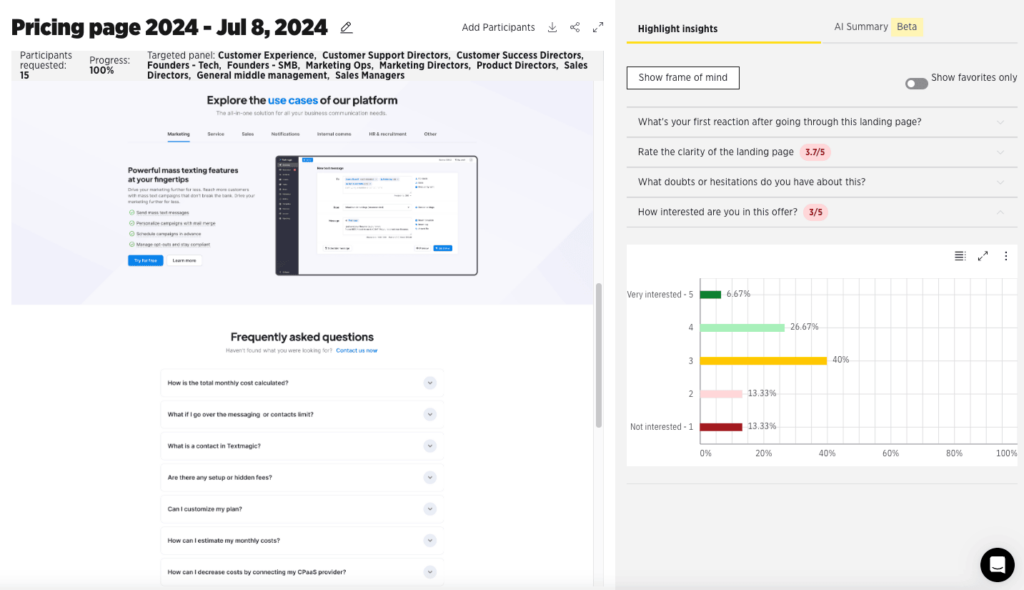
Image source: screenshot by the author
Wynter is a message-testing platform designed to help businesses refine their marketing messages by gathering structured, real-world feedback from targeted audiences — like the Five Second Speed Test we’ve just described, but with more options.
Wynter is great for full-page messaging tests and landing page tests. You can choose industries, geos, and seniority levels—and experts that match these criteria will provide highly detailed feedback on the content you submit, including their first impressions: Is the page convincing? How did you feel going through the page? etc. This is extremely useful for refining the message that goes with your unique value proposition.
Wynter also offers target customer surveys, preference tests, 1:1 interviews, and demos on demand to help companies refine their GTM strategy. We strongly recommend Wynter for testing your landing page’s messaging and unique selling proposition.
What landing page optimization tools does Wynter offer?
- Landing page and full-page tests: Evaluate how well your messaging and LP design resonate with your target audience.
- Copy testing and surveys with industry experts: Wynter panels allow you to test your messaging against real users by filtering panel members according to their seniority level, geo-location, industry, etc.
- Qualitative feedback collection: Detailed comments from real users to gain deeper insights into their perceptions and suggestions.
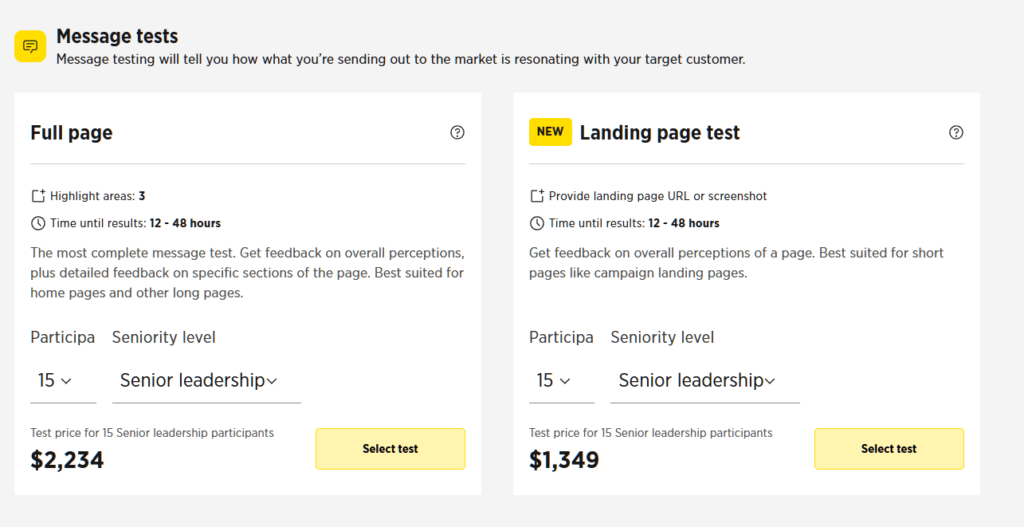
Image source: screenshot from the author
Wynter Pros and Cons
Pros:
- Ease of use: Simple setup and execution of tests make it accessible for users without extensive technical knowledge.
- Lightning-fast results: Feedback is collected in less than 48 hours and is, in most cases, highly relevant and detailed.
- Targeted feedback: Allows testing with specific audience segments, ensuring that feedback is relevant and actionable.
Cons:
- Wynter is only suitable for market research and messaging validation. It primarily focuses on message testing and does not provide more advanced optimization features like A/B testing or in-depth analytics.
- Significant costs: It is expensive, especially for frequent testing or large-scale feedback collection.
Wynter Pricing
- Free plan ❌
- Pay-as-you-go: only pay for the tests you want to run with results in 12-48 hours.
- Lite plan: starts at $6,990/year and includes premium audience segmentation filters and custom questions.
- Pro Plan: starts at $19,000/year and includes everything in Lite, plus research advisory and screener questions.
- Elite Plan: starts at $29,000/year and includes everything in Pro, plus dedicated research advisory and results analysis.
Our Verdict on Wynter
Wynter is invaluable for gathering targeted, actionable feedback from real users. However, its main drawback is the limited scope and higher cost. For those specifically interested in enhancing their messaging, Wynter offers impactful insights that can significantly improve their landing page performance.
6. PageVitals: To Monitor and Improve Landing Page Speed
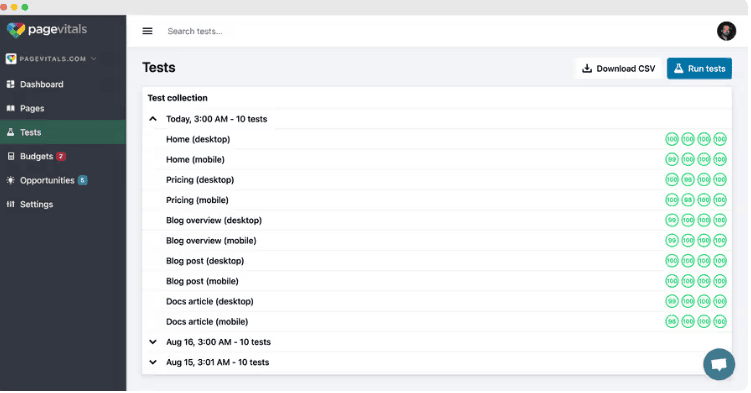
Image source: pagevitals.com
Speed is the dealbreaker when it comes to landing pages — well…that and desktop-first design. Most website traffic nowadays comes from mobile devices, yet marketers still optimize their pages for desktop.
PageVitals gives you the exact picture of what is slowing down your landing page and how you can fix it. You can use free tools like Google Search Console or Core Web Vitals, but running manual checks on all website pages can be time-consuming and nerve-wracking. PageVitals automates the process of getting Core Web Vitals metrics for many pages at once, adding notifications about declining metrics.
The tool also provides detailed insights into performance metrics at regular intervals, enabling you to identify and address issues affecting page load times and overall user experience. Is it that HubSpot form? Or your embedded video? PageVitals will tell you exactly what’s wrong and help you fix it. It is particularly useful for ensuring that landing pages are fast, efficient, and user-friendly.
What Landing Page Optimization Tools Does PageVitals Offer?
- Page Speed Insights: Regularly analyzes the speed of your landing pages through Lighthouse and Waterfall tests and offers recommendations for improvement.
- Mobile optimization: Evaluates how landing pages perform on mobile devices, ensuring a consistent user experience across all platforms.
- Monitors key speed performance metrics: Evaluates First Contentful Paint (FCP), Largest Contentful Paint (LCP), Cumulative Layout Shift (CLS), and other components of page speed optimization elements to provide a complete picture of page performance.
PageVitals Pros and Cons
Pros:
- Quick resolution for speed issues: This feature provides real-time insights into landing page performance, allowing for quick identification and resolution of issues.
- Easy-to-understand performance reports: Offers detailed reports on various performance metrics, helping users understand and improve page speed and efficiency.
- UX reports: Monitors key UX metrics to help improve the overall user experience on landing pages.
Cons:
- Too technical: While it is important to see all the technical information related to speed, the dashboard takes some time to get used to.
- New on the market: This is not necessarily a problem, but being relatively new means the platform still has bugs and lacks documentation.
PageVitals pricing
- Free plan ❌ – there is a 14-day free trial with 300 tests included.
- Starter plan: $12/month, 1,000 synthetic tests, 50,000 field tests, Lighthouse and Waterfall reports, and more for two websites.
- Growth plan: $39/month, everything in Starter, 5,000 synthetic tests, 250,000 field tests, REST API, webhooks, and more for 10 websites.
- Pro plan: $79/month; everything in Growth, 10,000 synthetic tests, 2 million field tests, and more.
Our Verdict on PageVitals
PageVitals is ideal for businesses looking to optimize and monitor the speed and performance of their landing pages. The platform will give you an edge over competitors who manually evaluate and fix speed issues.
7. Zuko: To Analyze and Improve Forms
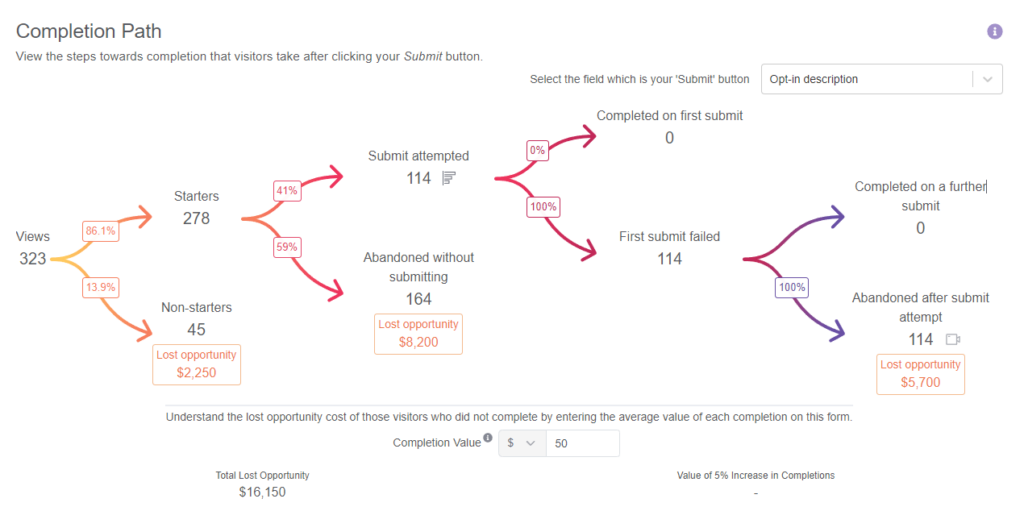
Image source: screenshot by the author
Zuko is a form optimization and tracking tool designed to help businesses optimize their web forms and improve conversion rates. It drills down into every interaction that a user takes on forms to help identify and address issues that may be causing friction or abandonment. It’s especially useful for landing pages with lead capture forms.
We only discovered Zuko recently when we noticed a spike in form abandonment. Our team introduced a series of longer forms requiring manual verification and needed a tool to help identify issues. Zuko helped us quickly identify fields that resulted in high abandonment and it was relatively easy to implement.
What Landing Page Optimization Tools Does Zuko Offer?
- Form and field analytics: Field analysis pinpoints which field is causing the most friction and abandonment, while form analytics gives you a comprehensive overview of your visits, starters, and completions.
- Conversion tracking: Measures the effectiveness of forms and every micro-interaction in converting visitors into leads or customers.
- Session replay Allows you to see exactly where your customers struggle. It also comes with a powerful filtering system that allows you to isolate relevant recordings.
- Form builder: Create embedded, standalone, multi-step forms that automatically collect user behavior data and are GDPR-compliant.
Zuko Pros and Cons
Pros:
- Hyper-detailed form data: Detailed form insights shed light on how users interact with forms, helping to identify and resolve issues.
- Visual confirmation of key landing page issues: Session Replay lets you watch user sessions and clearly understand user behavior and interaction patterns.
Cons:
- Specialized in form building and analytics: This company primarily focuses on form optimization and may not offer comprehensive landing page optimization features like full-page analytics or heatmaps for the entire page. For example, Mouseflow also offers form and field analytics but provides many other useful behavior analytics tools, such as heatmaps and conversion funnels.
- Requires technical knowledge: Some insights and recommendations may require technical expertise to implement effectively.
Zuko pricing
The prices below refer to Zuko’s analytics platform. The form builder has different pricing, starting from $28 per month.
- Free plan ✅ – Only available for the Zuko form builder.
- Paid plans start at $70 per month (for up to 5,000 sessions) and increase based on the number of form sessions.
Our Verdict on Zuko
For businesses looking to analyze their landing page forms in depth and improve conversion rates, Zuko can be quite useful. It provides hard-to-ignore data for each form field or interaction but requires some basic knowledge of analytics tracking code implementation. Thankfully, Zuko also provides detailed installation guides, so if you have the patience to learn, it can become an invaluable landing page optimization tool.
8. HelloBar: For Banners and Pop-Ups
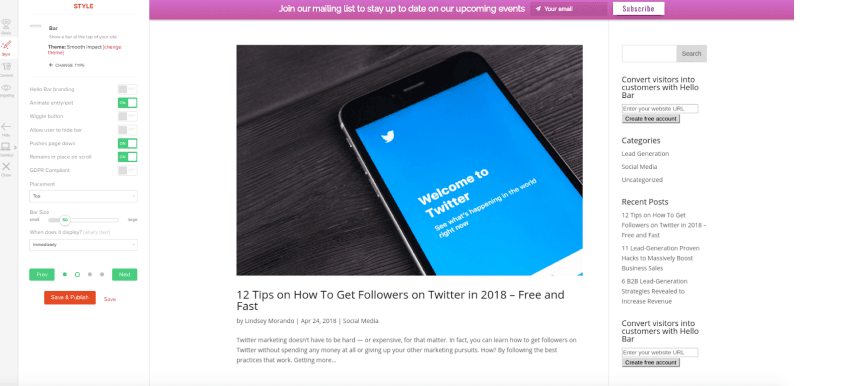
Image source: www.hellobar.com
HelloBar is designed to help businesses capture leads and drive conversions through engaging banners, pop-ups, and other on-site messaging. It works well for increasing sign-ups, promoting special offers, and guiding visitors toward key pages on a website.
We’ve been using Hellobar for years now. It works fine for pop-ups and banners, especially considering its low price and relatively easy installation. You can also choose from quite a few templates and formats.
One limitation of HelloBar is its inconsistent mobile responsiveness, which may require additional customization to ensure optimal display across devices. Additionally, the limited font support can pose challenges in maintaining brand consistency. Users might need to explore alternative tools or workarounds to achieve a cohesive design experience.
What Landing Page Optimization Tools Does HelloBar Offer?
- Different pop-ups and modals include bars, alerts, sliders, page takeovers, and in-line forms.
- Custom pop-up triggers: Exit intent technology captures visitors’ attention just before they leave the site to reduce bounce rates and increase conversions. You can also set other triggers to have Hellobar forms pop up.
- Targeting and segmentation capabilities: Display messages based on visitor behavior, location, referral source, and other criteria.
- Customizable templates: Different types of form templates that can be adjusted to match the branding and goals of any website.
- Reporting features: These allow you to see how many times a pop-up was viewed, clicked, closed, etc.
HelloBar Pros and Cons
Pros:
- Easy to use: The intuitive interface and simple setup make it accessible for all skill levels.
- Customizable: Offers various customization options to match branding and specific goals.
- A/B testing capabilities: Allows you to A/B test different types of pop-ups and modals through traffic splitting.
Cons:
- Basic reporting: It may not offer comprehensive analytics like more advanced optimization tools.
- Not enough templates: Most templates provided are basic or poorly optimized for mobile devices.
HelloBar Pricing
- Free plan ✅ – Basic features with limited customization options, up to 5,000 views.
- Growth plan: $39/month, up to 50,000 monthly pop-up views, and unlimited pop-ups, subscribers, or A/B tests.
- Premium plan: $69/month, up to 150,000 monthly pop-up views.
- Elite plan: $129/month, up to 500,000 monthly pop-up views.
Our Verdict on HelloBar
HelloBar allows for the quick implementation of pop-up modals for lead capturing based on user behavior. While the potential intrusiveness of pop-ups and the relatively higher cost may put off some businesses, the tool does exactly what it promises with no headaches.
9. UserTesting: For, Well, User-Testing
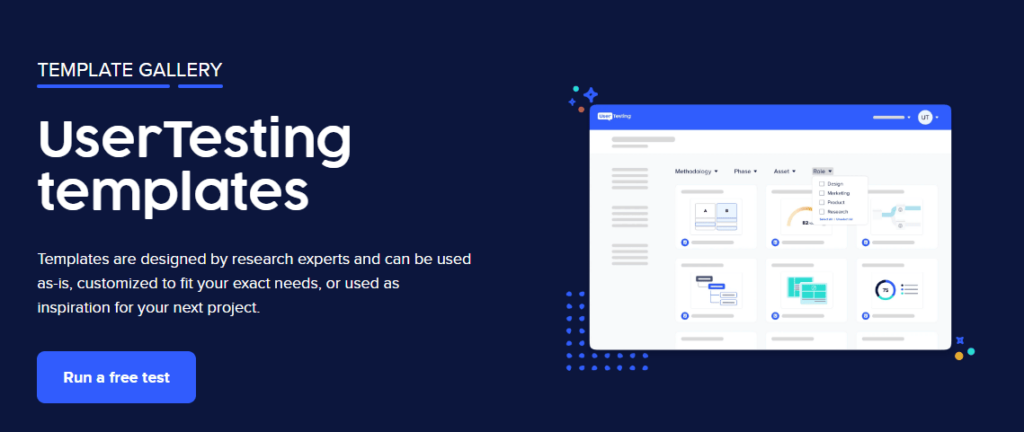
Image source: www.usertesting.com
UserTesting provides businesses the tools to gather real-time feedback and insights from their target audience. By facilitating the creation of customized tests and surveys, the platform empowers companies to observe and understand how users interact with their landing pages, mobile apps, and other digital products.
What Landing Page Optimization Tools Does UserTesting Offer?
- Usability tests: Employs usability testing to identify UX issues and areas for improvement through high-quality feedback.
- User testing templates: Quickly customize user testing templates to help you validate ideas and identify issues early on.
- Feedback engine: Collect qualitative feedback through conversations, usability tests, surveys, and open-ended questions to understand user preferences and pain points.
- Video recordings: See how other users experience your landing page or software. Audio recording, screen capture, clickstream data, and questions or comments are included.
UserTesting Pros and Cons
Pros:
- Fast insights from real users: Conducts real-time tests with real users to observe their interactions and gather feedback.
- AI-powered experience: Speed up the research process by letting UserTesting’s AI analyze your data, discover patterns, and summarize key learnings.
Cons:
- Clunky dashboard: Some users reported crashes, bugs, and glitches alongside a cumbersome dashboard.
- Data quality varies: The quality and relevance of feedback will vary based on the sample audience used for testing.
UserTesting Pricing
UserTesting does not provide public pricing information for its product.
- Free plan ❌
- Essential Plan: Custom pricing based on the number of tests and specific needs, starting at around $49 per participant.
- Advanced Plan: Custom pricing with additional features and higher testing volumes.
- Enterprise Plan: Tailored solutions for large organizations with extensive testing needs, providing advanced features and dedicated support.
Our Verdict on UserTesting
UserTesting is mainly used to gain deep insights into user behavior and preferences. Its comprehensive suite of testing options provides a clear understanding of how users interact with landing pages.
The cost may be a consideration for smaller businesses, but overall, this platform is dedicated to any business looking to improve user satisfaction through a mix of qualitative and quantitative insights.
10. Varify: For A/B Testing (Not Only) Landing Pages

Source: Varify
After Google’s Optimize tool was sunset in September 2023, many marketers found themselves without A/B testing tools. Most standalone options were either technically complex, expensive, or both.
This created a niche for Varify, an A/B testing tool that is very cheap compared to its competition. If you have no experience with similar tools, Varify makes it easy to get started and offers more than enough functionality to cover all your A/B testing needs.
What Landing Page Optimization Tools Does Varify Offer?
- Parallel A/B testing: Run A/B tests on your websites to identify opportunities to improve conversion rates.
- Multipage and multivariate testing: Test whether a full conversion funnel works better than the original one or identify winning variants amongst multiple variations of one page.
- Automatic goals are probably the best feature for beginners since Varify automatically identifies and measures relevant goals without using cookies.
- Advanced targeting options include page, event, audience, IP address targeting, and the possibility of adding other targeting parameters.
Varify Pros and Cons
Pros:
- Beginner-friendly: Varify’s intuitive interface makes it accessible to users of all skill levels so they can customize their tests in the visual editor.
- Cookieless goal setting: Varify does not use cookies to set goals. This is a huge plus, considering the recent developments with Google Analytics 4 and Google Consent Mode.
- Visual and codeless editor: For effortless creation of A/B test variants.
Cons:
- Limited integration options: Some users mentioned that Varify still lacks essential integration capabilities.
- Complex targeting is only possible with coding knowledge.
Verify Pricing
- Free plan ❌ – there is a 30-day trial available.
- Single domain pricing: starts at $139/month if billed monthly and allows A/B testing for unlimited traffic, experiments, and team members for one site.
- Agency pricing: starts at $283/month for up to 3 domains, with a monthly billing.
Our Verdict on Varify
Varify offers a cost-effective solution for A/B testing, making it accessible to businesses with limited budgets. However, it lacks some advanced features found in more expensive competitors, such as detailed analytics and user segmentation. Still, considering its price and potential, we believe it’s a worthy successor to Google Optimize.
Which Landing Page Optimization Tool is The Best for You
The tools listed above cater to unique landing page optimization needs. You will need a mix of products that cover different needs, such as user testing, conversion rate optimization, or landing page building.
Some platforms offer several tools in one, like Hubspot, which has a landing page builder, A/B testing, and analytics, or Mouseflow, which provides both quantitative and qualitative analytics together with form analytics. However, no landing page optimization software covers everything.
Remember, the best tool is the one that aligns with your specific goals and integrates seamlessly with your existing systems. As you explore these options, focus on what matters most to your business: ease of use, detailed analytics, or advanced customization. Investing in the right tools can turn your landing pages into conversion powerhouses, driving growth and success in 2024 and beyond.


